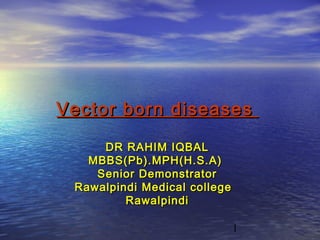
Vector born diseases
- 1. Vector born diseases DR RAHIM IQBAL MBBS(Pb).MPH(H.S.A) Senior Demonstrator Rawalpindi Medical college Rawalpindi 1
- 2. Vector born diseases Vector It is defined as an arthropod or any living carrier (e.g. snail) that transport an infectious agent to a susceptible individuals. The transmission by a vector may mechanical or biological 2
- 3. Arthropods-borne diseases Arthropods Diseases transmitted Mosquito Malaria, Filariasis, Dengue, Yellow Fever Housefly Typhoid, Diarrhea, Gastro-enteritis Amoebiasis, Poliomyelitis, Trachoma Sand fly Kalaazar, Sand fly fever, Oraya Fever Tsetse fly Sleeping Sickness Louse Epidemic Typhus, Relapsing fever Rat Flea Plague, endemic typhus Black Fly Onchocerciasis 3
- 4. Arthropods-borne diseases Hard tick Viral Hemorrhagic fever, Tick Paralysis , Viral Encephalitis Soft Tick Q fever, Relapsing Fever Itch Mite Scabies Cyclops Guinea-worm disease, Fish tape worm Cockroach Enteric pathogens 4
- 5. LYMPHATIC FILARISIS 5
- 6. LYMPHATIC FILARIASIS The term “LYMPHATIC FILARIASIS” covers infection with three closely related nematode worms – W. bancrofti, B. malayi and B. timori. All three infections are transmitted to man by the bites of infective mosquitoes. All three parasites have basically similar life cycles in man. 6
- 7. HUMAN FILARIAL INFECTIONS ORGANISM VECTORS DISEASE PRODUCED Wuchereia bancrofti Culex Mosquitoes Lymphatic filariasis Brugia malaya Mansonia -”- -”- -”- Brugia timori Anopheles -”- -”- -”- Mansonia -”- Onchocera volvulus Simultum flies Subcutaneous nodules; River blindness Loa loa Chrysops flies Recurrent, transient subcutaneous swellings T. Perstans Culicoides Probably rarely any clinical illness T. Streptocerca -”- -”- -”- Mansonella ozzardi -”- 7 -”- -”-
- 8. AGENT FACTORS a) Periodicity b) Life Cycle c) Reservoir of infection 8
- 9. HOST FACTORS a) Age b) Sex c) Migration d) Immunity e) Social Factors 9
- 10. ENVIRONMENTAL FACTORS a) Climate b) Drainage c) Town Planning 10
- 11. VECTORS OF LYMPHATIC FILARIASIS 11
- 12. MODE OF TRANSMISSION Filariasis is transmitted by the bite of infected vector mosquitoes. The parasite is deposited near the site of puncture. It passes through the punctured skin or may penetrate the skin on its own and finally reach the lymphatic system. The dynamics of transmission depends upon the man mosquito contact (e.g. infective biting rate). 12
- 13. 1). Incubation period 8 to 16 months 2). Clinical manifestations a) lymphatic filariasis b)occult filariasis 13
- 14. 1. LYMPHATIC FILARIASIS: a). Asymptomatic microfilaraemia b). Asymptomatic microfilaraemia c). Stage of acute manifestations d). Stage of chronic obstructive lesions 2. OCCULT FILARIASIS: The tem occult or cryptic filariasis refers to filarial infections in which the classical clinical manifestations are not present and Mf are not found in the blood. 14
- 15. FILARIA SURVEY The size of the sample to be examined I a filaria survey varies with the type of survey, whether it is a routine survey or survey for evaluation. 1. Mass Blood Survey * The thick film * Membrane filter concentration method * DEC provocation test 2. Clinical Survey 3. Xenodiagnosis 4. Entomological Survey 15
- 16. ASSESSMENT OF FILARIA CONTROL PROGRAMMES 16
- 17. 1. Clinical Parameters 2. Parasitological -”- a). Microfilaria Rate b). Filarial Endemicity Rate c). Microfilarial Density d). Average Infestation Rate 3. Entomological Parameters 17
- 18. Control measures • CHEMOTHERAPY: a). Diethylcarbamazine b). Filaria control in the community (i). Mass Therapy (ii). Selective treatment (iii). DEC medicated salt (iv). Ivermectin 18
- 19. 1. VECTOR CONTROL: a). Antilarval measures (i). Chemical control (ii). Removal of Pistia Plant (iii). Minor environmental measures b). Anti-adult measures c). Personal Prophylaxis 19
- 20. LEISHMANIASIS 20
- 21. LEISHMANIASIS “Leishmaniasis are a group of protozoal diseases caused by parasites of the genus Leishmnania, and transmitted to man by the bite of female phlebotomine sandfly.” they are responsible for various syndromes in human beings 1. kalaazar or visceral leishmaniasis (VL) 2. cutaneous leishmaniasis (CL) 3. mucocutaneous leishmaniasis (MCL) 4. anthroponotic cutaneous leishmaniasis (ACL) 5. zoonotic cutaneous leishmaniasis (ZCL) 21
- 22. AGENT FACTORS: a). Agents b). Reservoirs of infection HOST FACTORS: a). Age b). Sex c). Population Movement d). Socio-economic status e). Occupation f). Immunity 22
- 23. ENVIRONMENTAL FACTORS: a). Altitude b). Season c). Rural Areas d). Vectors e). Development projects MODE OF TRANSMISSION: From man to man by the bite of female phlebotomine sandfly or P. argentipes 23
- 24. INCUBATION PERIOD 1to 4 months range is 10 days to 2 years Clinical Features: 1). Kala Azar (VL) 2). Cutaneous Leishmaniasis 3). Mucocutaneous Leishmaniasis Laboratory diagnosis: 1). Parasitological diagnosis 2). Aldehyde test 3). Serological tests 4). Leishmanin (Montenegro) test 5). Haematological findings 24
- 25. CONTROL MEASURES 1 Control of reservoir: * Treatment * Animal reservoirs 2. Sandfly control 3. Personal prophylaxis 25
- 26. SCABIES 26
- 27. SCABIES • Discovered – 1687 • Sarcoptes Scabiei / Acarus Scabiei – very small • The female parasite burrows into the epidermis where it breeds and causes the condition known as scabies / itch. • Species of germs – infest animals like dogs, cattle & horse. 27
- 28. 28
- 29. DIAGNOSIS OF SCABIES The main diagnostic features of scabies are: a). The patient complains of itching which is worse at night. b). Examination reveals follicular lesions at the affected site c). Secondary infection leads to crusted papules and pustules d). The diagnosis is probable if the other members of the household are affected e). Confirmation of the diagnosis may be made by searching for the parasite in the skin debris under microscope. 29
- 30. Treatment of scabies 1. Benzyl Benzoate 2. HCH 3. Tetmosol 30
- 31. GENERAL VIEW Nam Causative Ho Reservo Mode of e of Agent st ir Transmission Dise ase Sarcoptes Man •Man 1. Direct Transmission Scabi Scabiei or •Sometime Direct close free es Acarus Scabiei s Domestic contact with infected (Itch Mite) Animals person. Via a). Hand shaking b). Embracing c). Sleeping together etc. 1. Indirect Transmission It is via using non 31 living things
- 32. 32
Notas del editor
- Very important
